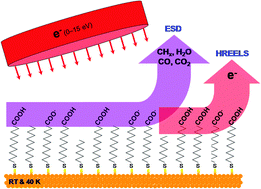Selective terminal function modification of SAMs driven by low-energy electrons (0–15 eV)
Abstract
Low-energy electron induced degradation of a model self-assembled monolayer (SAM) of acid terminated

* Corresponding authors
a
Univ Paris-Sud, Institut des Sciences Moléculaires d'Orsay (ISMO), UMR 8214, Orsay, France
E-mail:
anne.lafosse@u-psud.fr
b CNRS, Orsay, France
c Laboratoire de Réactivité de Surface (LRS) UMR CNRS 7197 Université Pierre & Marie Curie – 4 place Jussieu, case 178, 75252 Paris Cedex 05, France
Low-energy electron induced degradation of a model self-assembled monolayer (SAM) of acid terminated

 Please wait while we load your content...
Something went wrong. Try again?
Please wait while we load your content...
Something went wrong. Try again?
J. Houplin, L. Amiaud, V. Humblot, I. Martin, E. Matar, R. Azria, C.-M. Pradier and A. Lafosse, Phys. Chem. Chem. Phys., 2013, 15, 7220 DOI: 10.1039/C3CP43750G
To request permission to reproduce material from this article, please go to the Copyright Clearance Center request page.
If you are an author contributing to an RSC publication, you do not need to request permission provided correct acknowledgement is given.
If you are the author of this article, you do not need to request permission to reproduce figures and diagrams provided correct acknowledgement is given. If you want to reproduce the whole article in a third-party publication (excluding your thesis/dissertation for which permission is not required) please go to the Copyright Clearance Center request page.
Read more about how to correctly acknowledge RSC content.
 Fetching data from CrossRef.
Fetching data from CrossRef.
This may take some time to load.
Loading related content
